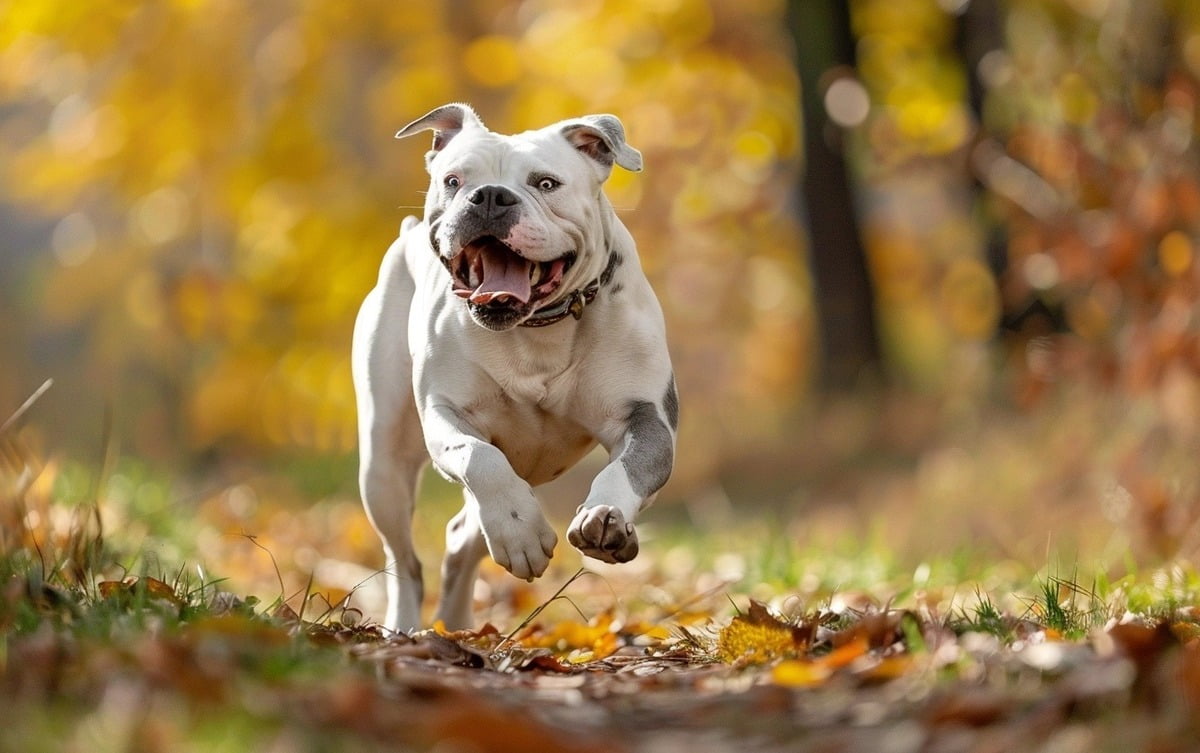The American Bulldog is a medium-sized, muscular dog with a short coat. It is known for its loyalty, affection, and playful personality. The American Bulldog is a relatively new breed, having been developed in the early 19th century. It is a descendant of the Old English Bulldog, which was brought to the United States by English immigrants. The American Bulldog was originally bred for farm work, but it is now a popular companion animal.
History: A Working-Class Legacy
The American Bulldog’s story is one of resilience and adaptation. Like many working breeds, their roots trace back to the Old English Bulldog, a canine known for its strength and tenacity. When English immigrants journeyed to the United States, they brought along their loyal bulldogs to help with various tasks on farmsteads.
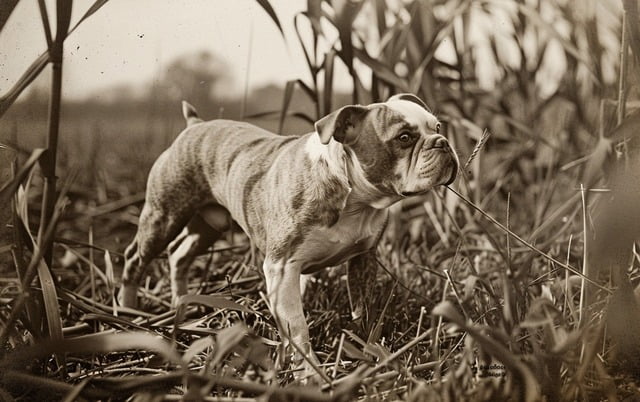
The Bulldog’s American Transformation
Over time, the American Bulldog evolved into a slightly different type of dog. The harsh demands of the American frontier shaped their physique and temperament. They needed to be versatile, capable of guarding livestock, hunting wild game, and even wrangling unruly cattle.
The American Bulldog’s journey wasn’t always smooth sailing. In the early 20th century, their numbers dwindled due to factors like changing agricultural practices and the rise of dog fighting bans. However, dedicated breeders and enthusiasts recognized the breed’s unique qualities and worked tirelessly to preserve it.
The American Bulldog’s adaptability and strong work ethic make it a popular choice for crossbreeding with other loyal, family-friendly breeds. One popular mix is The American Bulldog Lab Mix, also known as the Bullador, which combines the strength and loyalty of the American Bulldog with the friendly, outgoing nature of the Labrador Retriever. This hybrid breed is well-suited for families, bringing together the best traits of both parent breeds for a companion that’s not only protective but also gentle and social.
A Second Chance for the American Bulldog
The latter half of the 20th century saw a resurgence in the American Bulldog’s popularity. Their loyal and protective nature made them sought-after family companions. Today, the American Bulldog is a cherished breed, celebrated for its working-class roots and its ability to adapt to modern life.
The American Bulldog’s history is a testament to the enduring bond between humans and canines. It’s a story of how a breed can transform and thrive, even when faced with challenges. It’s a reminder that dogs are more than just pets – they’re working partners, guardians, and members of our families.
Appearance: A Study in Strength and Athleticism
The American Bulldog is a sight to behold, a symphony of muscle and power. Their physique hints at their working-dog origins, but their expressive eyes and playful demeanor reveal a softer side.

A Palette of Colors and Patterns
One of the most captivating aspects of the American Bulldog is the diversity of their coat colors and patterns. They come in a spectrum of hues, from classic white to rich brindle, and even shades of fawn and red. Some sport striking piebald markings, while others boast a solid, single color. This variety adds to their charm and allows every American Bulldog to have a unique look.
Size and Stature: A Medium-Large Breed
American Bulldogs typically fall into the medium-to-large category, with males weighing between 60 and 120 pounds and females ranging from 50 to 90 pounds. They stand between 20 and 28 inches tall at the shoulder, possessing a sturdy frame that exudes strength and athleticism.
Distinctive Features: Beyond the Basics
Their broad head, short muzzle, and wide jaw are unmistakable trademarks of the breed. Their ears can be either cropped or left natural, adding to the diversity of their appearance. The American Bulldog’s eyes, often described as ” soulful,” are full of expression and can range in color from hazel to dark brown.
Beyond their physical attributes, American Bulldogs possess an undeniable presence. Their confident gait and alert posture command attention, while their playful nature and gentle demeanor endear them to those they meet.
Whether you’re drawn to their classic white coat, their striking brindle pattern, or their playful personality, the American Bulldog is a breed that leaves a lasting impression. Their appearance is a testament to their working-dog heritage and their ability to adapt to modern life as cherished companions.
Temperament: The Heart of an American Bulldog
Beneath their muscular exterior lies a heart full of loyalty, affection, and a zest for life. American Bulldogs are not just dogs; they’re family members, protectors, and playmates rolled into one lovable package.
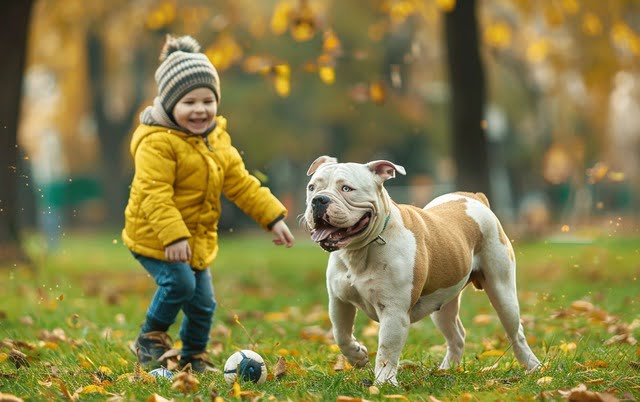
Loyalty That Knows No Bounds
One of the most endearing qualities of the American Bulldog is their unwavering loyalty. They form deep bonds with their families and are fiercely protective of their loved ones. This loyalty is rooted in their working-dog heritage, where they were tasked with guarding property and livestock. Today, that same loyalty translates into a devoted companion who will always have your back.
Affectionate and Playful Companions
While they take their guardian role seriously, American Bulldogs are also known for their affectionate and playful nature. They thrive on human interaction and love to be involved in family activities. Whether it’s a game of fetch in the backyard or a cuddle session on the couch, American Bulldogs are always up for fun and adventure.
Intelligent and Eager to Please
American Bulldogs are intelligent dogs that are eager to please their owners. This makes them relatively easy to train, especially with positive reinforcement methods. They excel in various dog sports and activities, such as agility, obedience, and weight pulling. Their intelligence and willingness to learn make them versatile companions who can adapt to a variety of roles.
Independent Thinkers with a Stubborn Streak
While their intelligence and eagerness to please make training enjoyable, American Bulldogs can also be independent thinkers with a stubborn streak. They require a firm but gentle hand in training, and consistency is key. Early socialization is crucial to ensure they grow up to be well-adjusted and confident dogs.
The American Bulldog’s temperament is a blend of loyalty, affection, intelligence, and a touch of stubbornness. This unique combination makes them devoted companions, playful friends, and reliable protectors. Their temperament is a testament to their rich history and their ability to thrive in modern life as beloved family members.
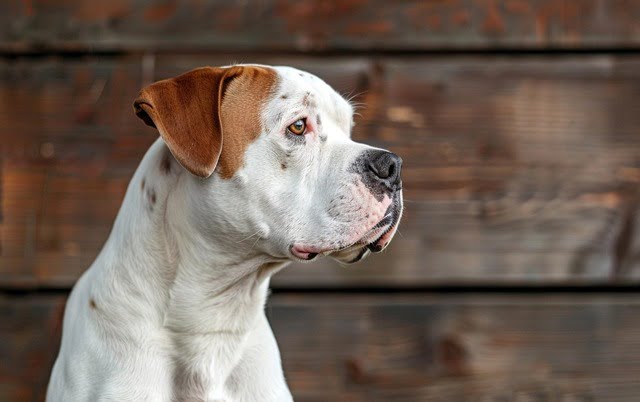
Care: Nurturing Your Bulldog Companion
Caring for an American Bulldog is a rewarding experience, filled with wagging tails, slobbery kisses, and shared adventures. While they may be sturdy and resilient, these dogs have specific needs that must be met to ensure they live long, healthy, and happy lives.
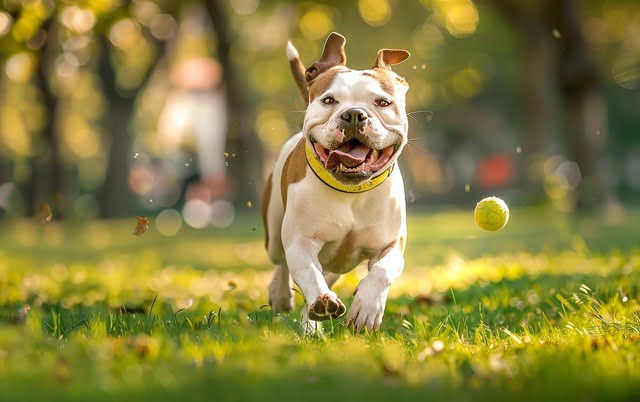
Exercise: Fueling Their Energy
American Bulldogs are energetic dogs that need regular exercise to stay physically and mentally stimulated. A daily walk, jog, or playtime in a securely fenced yard is essential. They also enjoy interactive games like fetch and tug-of-war. Regular exercise not only helps them maintain a healthy weight but also prevents behavioral problems that can arise from pent-up energy.
Nutrition: A Balanced Diet for a Healthy Pup
Feeding your American Bulldog a balanced diet is crucial for their overall well-being. High-quality dog food that is appropriate for their age, size, and activity level is recommended. Avoid overfeeding, as American Bulldogs are prone to obesity, which can lead to various health issues. Consult with your veterinarian to determine the right amount and type of food for your Bulldog.
Grooming: Keeping It Simple
One of the perks of owning an American Bulldog is their low-maintenance grooming needs. Their short coat requires minimal brushing to remove loose hairs and dirt. Regular baths are not necessary unless they get exceptionally dirty. However, pay attention to their wrinkles, especially around the face and tail, as these areas can trap moisture and debris, leading to skin irritation. Cleaning these folds regularly with a damp cloth can help prevent problems.
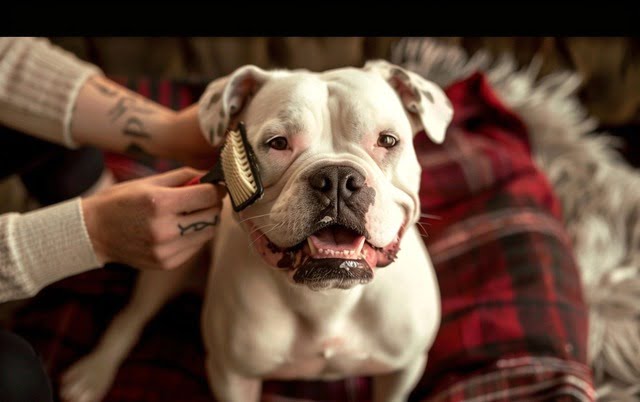
Training and Socialization: Building a Well-Rounded Dog
Training and socialization are vital for American Bulldogs. Start training early and use positive reinforcement techniques like treats and praise. These dogs are intelligent and eager to please, but they can also be stubborn, so patience and consistency are key. Socialization is equally important, exposing them to various people, animals, and environments from a young age. This helps them become well-adjusted, confident, and friendly companions.
By understanding and meeting their specific needs, you can provide your American Bulldog with the best possible care, ensuring a long, healthy, and fulfilling life by your side. Remember, a well-cared-for Bulldog is a happy Bulldog, and their unwavering loyalty and affection will be a constant source of joy in your life.
Health: A Lifelong Commitment to Wellness
While American Bulldogs are generally healthy dogs, they are prone to certain health conditions, as with any breed. Being aware of these potential issues and taking proactive measures can help ensure your furry friend enjoys a long and vibrant life.
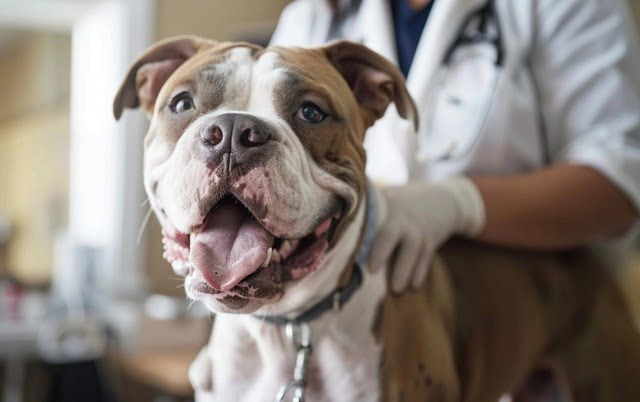
Lifespan and Common Health Concerns
The average lifespan of an American Bulldog is 10-12 years. However, with proper care and attention to their health, many Bulldogs live well into their teens. Some common health concerns to be aware of include:
- Hip and Elbow Dysplasia: This is a genetic condition affecting the joints, leading to pain and mobility issues. Responsible breeders screen for these conditions and should provide health clearances for their dogs.
- Brachycephalic Syndrome: Due to their short snouts, American Bulldogs can experience breathing difficulties, especially in hot or humid weather. Be mindful of their activity levels and provide ample shade and water during warm weather.
- Skin Allergies: These can cause itching, redness, and discomfort. Regular grooming and a balanced diet can help manage allergies.
- Eye Problems: Conditions like cherry eye and entropion can affect their vision and require veterinary attention.
- Cancer: Like many breeds, American Bulldogs can be susceptible to cancer. Regular vet checkups and early detection are crucial for managing this disease.
Proactive Measures for a Healthy Bulldog
Taking a proactive approach to your American Bulldog’s health can make a significant difference in their quality of life. Here are some essential steps you can take:
- Regular Vet Checkups: Schedule regular checkups with your veterinarian for preventive care, vaccinations, and early detection of health issues.
- Healthy Diet: Feed your Bulldog a high-quality diet that is appropriate for their age and activity level. Consult your vet for specific recommendations.
- Weight Management: Monitor your Bulldog’s weight and adjust their diet and exercise routine as needed to prevent obesity.
- Dental Care: Brush your Bulldog’s teeth regularly and schedule professional cleanings as recommended by your veterinarian to prevent dental disease.
- Environmental Considerations: Be mindful of extreme temperatures, as American Bulldogs are sensitive to heat and cold. Provide them with adequate shelter and protection from harsh weather conditions.
By taking these proactive measures and staying informed about potential health concerns, you can help your American Bulldog live a long, healthy, and happy life by your side. Remember, prevention is key when it comes to maintaining your furry friend’s well-being.
Conclusion: Is the American Bulldog the Right Breed for You?
Deciding to bring any dog into your life is a momentous choice, and choosing an American Bulldog is no different. These dogs offer a unique blend of loyalty, affection, and playful energy that can enrich your life in countless ways. However, it’s important to weigh the responsibilities that come with owning this breed carefully.
FAQ – Your American Bulldog Questions Answered
What are the key differences between the Johnson and Scott types of American Bulldogs, and which is better suited for families with children?
- Johnson Bulldogs: These tend to be larger and heavier, with a more muscular build and a wider head. They are known for their strength and athleticism and were traditionally used for working roles. Their temperament is typically more reserved and less outgoing than the Scott type. While they can be good family dogs, their size and strength may require extra caution with young children.
- Scott Bulldogs: These are generally smaller and lighter than Johnson Bulldogs, with a leaner build and a longer muzzle. They are known for their agility and speed and were often used for hunting. Their temperament is typically more friendly and outgoing than the Johnson type, making them well-suited for families with children. They are known to be playful and affectionate with their loved ones.
Ultimately, the best type of American Bulldog for your family will depend on your lifestyle and preferences. Consider your experience with dogs, your activity level, and the ages of your children when making your decision. It’s always best to meet with breeders and interact with individual dogs to assess their temperament and suitability for your family.
Beyond basic obedience, what unique activities or sports can I engage my American Bulldog in to challenge their intelligence and athleticism?
American Bulldogs are intelligent and energetic dogs that thrive on physical and mental stimulation. Here are some unique activities and sports that can challenge their abilities:
- Weight Pulling: This sport showcases their strength and determination as they pull weighted sleds or carts.
- Agility: This fast-paced sport tests their agility and obedience as they navigate through an obstacle course.
- Dock Diving: This exciting sport allows them to showcase their jumping ability as they leap off a dock into water.
- Nose Work: This scent detection sport taps into their natural instincts and provides a mental challenge.
- Therapy Dog Work: American Bulldogs, with their gentle and affectionate nature, can excel as therapy dogs, bringing comfort and joy to people in hospitals, nursing homes, and schools.
Are there specific mental enrichment games or puzzles that are particularly effective in preventing boredom-related behaviors in American Bulldogs?
Yes, mental enrichment is crucial for American Bulldogs to prevent boredom and destructive behaviors. Here are some effective options:
- Puzzle Toys: These toys dispense treats or kibble when the dog figures out how to manipulate them, providing a mental challenge and reward.
- Interactive Feeders: These feeders make mealtime more engaging by requiring the dog to work for their food.
- Hide-and-Seek: This classic game can be adapted for dogs by hiding treats or toys around the house or yard.
- Training Games: Teaching your Bulldog new tricks or commands provides mental stimulation and strengthens your bond.
- Chew Toys: Durable chew toys can help satisfy their natural chewing instincts and prevent them from chewing on inappropriate items.
How can I tell if my American Bulldog is showing early signs of joint problems or other health issues that are common in the breed?
Early detection of health issues is crucial for prompt treatment and a better quality of life for your American Bulldog. Watch for these signs:
- Joint Problems: Limping, stiffness, reluctance to jump or climb stairs, difficulty getting up or lying down.
- Skin Allergies: Itching, redness, hair loss, ear infections.
- Eye Problems: Squinting, redness, discharge, excessive tearing.
- Brachycephalic Syndrome: Noisy breathing, snoring, exercise intolerance, collapsing during exertion.
If you notice any of these signs, consult your veterinarian promptly for diagnosis and treatment.

I could talk about dog breeds all day! My goal is to help you find the four-legged friend who fits your life like a perfectly worn-in tennis ball fits in a dog’s mouth.

